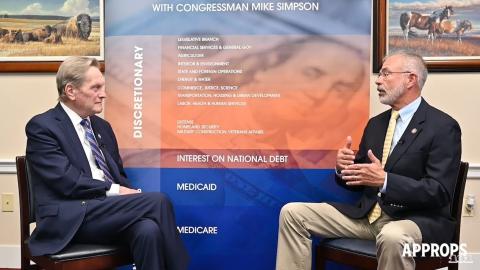Grow, Heal, Invest: Inside the Agriculture Appropriations Bill
Interior and Environment Subcommittee Chairman Mike Simpson's (R-ID) next Appropriations 101 discussion features Agriculture Subcommittee Chairman Andy Harris (R-MD), whose insights stem from nearly a decade of service on the subcommittee.
The dialogue unpacks common misconceptions about mandatory versus discretionary spending in the Agriculture Appropriations bill while exploring Dr. Harris's vision for integrating modern-day technology into federal programs.

Watch Subcommittee Chairman Simpson and Subcommittee Chairman Harris’s conversation here.
Harris: “The thing that's important, that you pointed out about discretionary and mandatory [spending] is that the largest part of the Agriculture Appropriations bill is actually mandatory. It's the SNAP program, one of the nutrition programs… More than $100-$130 billion is mandatory spending. We don’t have control over [mandatory spending]. We have control over the small nutritional part - that's the Women, Infants, and Children program.”
Simpson: “We need to be looking at, are there better ways to do things? Can we deliver our services better and in a cheaper way? Today, in Indian Health Services, I'm looking at whether going through Indian Health Services is the best way or is it better to appropriate money directly to the tribes – because nobody cares for their members more than the tribe members do. So, I don't know the answer to that, but we're looking into it. I’ve noticed that you've been one of the innovative people suggesting new ideas about how we might be able to do what we do and deliver services to our constituents better - not cutting services - just do it better than we [currently] do it.”
Harris: “That's right, better and more efficient. Just today, I had a meeting with – within my state –the people who run the Supplemental Nutrition Assistance Program (SNAP), the food stamp program. You know, the fraud rate is about 1-2%, and that doesn't sound big, but in a $100 billion program, that's $1-2 billion… For instance, when you use your credit card most times now, you're not using the swipe technology. You're using the chip technology, which is much more secure. Well, most people don't realize that for the SNAP program, you're using swipe technology. We’re using the old one, where you get the skimmers, you get that fraud, and so we're going to look at saying ‘okay, let's go to the new technology because it will save us probably $1-2 billion a year just by going to latest technology that everybody uses every other time.’ Everywhere else [people] go, they use [new technology] but not when they're using this federal program. This is an example of how we can go – and again, not cutting the benefit to anyone – just saying we're actually going to deliver the service more efficiently and more accurately… Our responsibility, as you know, we hold the purse strings, but just like you do in your family, or just like you do in your business, you have to make certain when you're spending that money, you're spending it wisely. You’ve got to spend it, but you’ve got to spend it wisely. And that's really called oversight. You make sure that these agencies are doing what they need to, and that they're delivering for the American people. In my case, mostly, for the American farmers and for rural areas that [government agencies are] delivering a product that's useful and efficiently delivered.”
###
